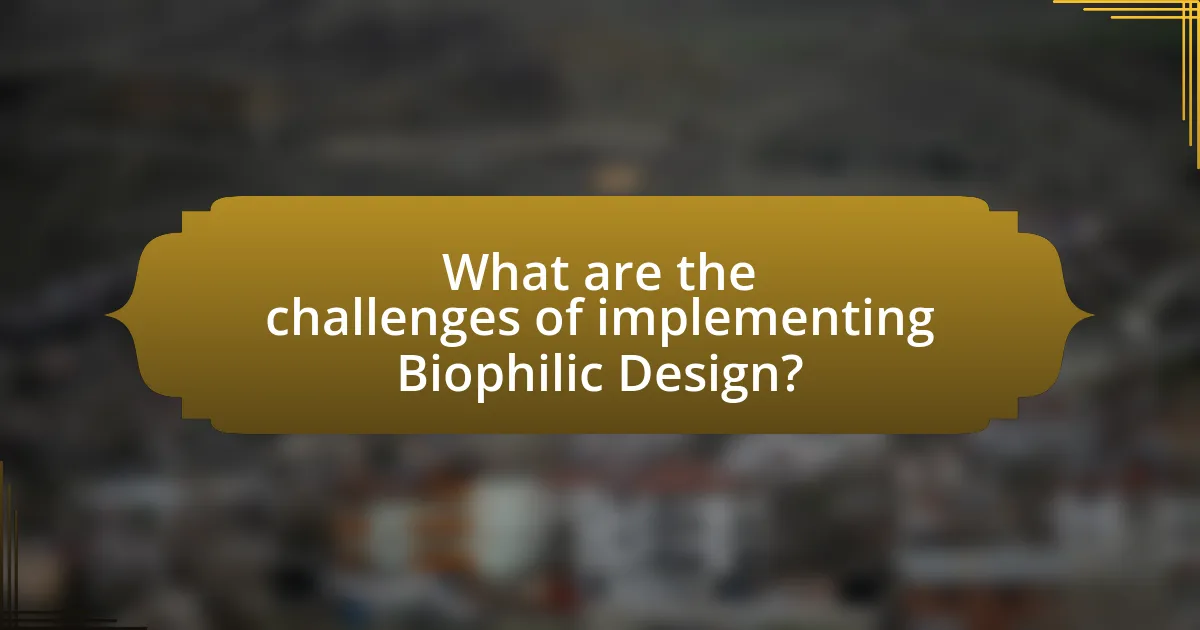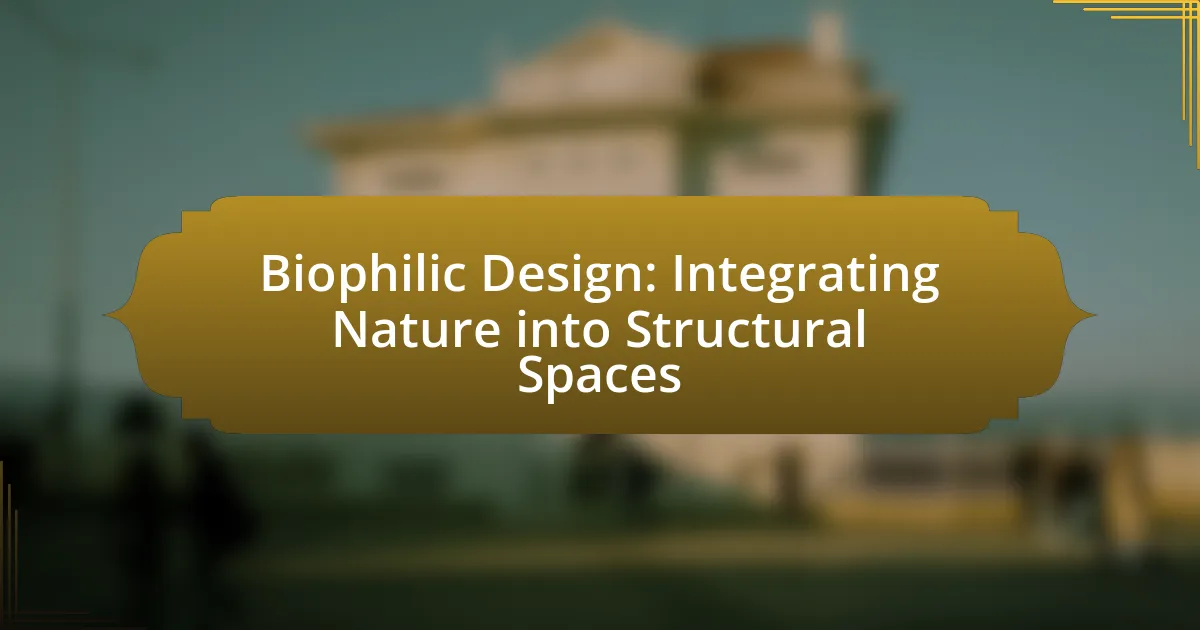Biophilic design is a design philosophy that emphasizes the integration of natural elements into built environments to enhance human well-being and productivity. This article explores the principles of biophilic design, including the incorporation of natural light, vegetation, and water features, and discusses its psychological benefits, such as reduced stress and improved cognitive function. It also examines the differences between biophilic and traditional architectural approaches, the importance of biophilic design in modern architecture, and the challenges faced in its implementation. Additionally, the article highlights the role of technology and best practices for effectively integrating biophilic design into architectural projects.

What is Biophilic Design?
Biophilic design is an approach that seeks to connect people with nature within built environments. This design philosophy incorporates natural elements, such as light, vegetation, and water features, to enhance well-being and productivity. Research indicates that environments designed with biophilic principles can reduce stress, improve mood, and increase cognitive function, as evidenced by studies showing that exposure to nature can lower cortisol levels and enhance overall health.
How does Biophilic Design integrate nature into structural spaces?
Biophilic Design integrates nature into structural spaces by incorporating natural elements such as light, vegetation, water features, and natural materials into architectural design. This approach enhances the connection between occupants and the natural environment, promoting well-being and productivity. Research indicates that environments designed with biophilic principles can reduce stress and improve cognitive function, as evidenced by a study published in the Journal of Environmental Psychology, which found that exposure to natural elements can significantly enhance mood and reduce anxiety levels.
What are the key principles of Biophilic Design?
The key principles of Biophilic Design include the incorporation of natural elements, the use of natural light, and the creation of spaces that foster a connection to nature. These principles aim to enhance human well-being and productivity by integrating nature into built environments. For instance, studies have shown that access to natural light can improve mood and reduce stress, while the presence of plants and natural materials can enhance cognitive function and creativity. Additionally, the design often emphasizes views of nature, natural ventilation, and the use of organic shapes, all of which contribute to a more harmonious and health-promoting environment.
How does Biophilic Design differ from traditional architectural approaches?
Biophilic Design fundamentally differs from traditional architectural approaches by prioritizing the integration of natural elements into built environments to enhance human well-being. While traditional architecture often focuses on functionality and aesthetics without a strong connection to nature, Biophilic Design emphasizes the psychological and physiological benefits of nature, such as reduced stress and improved mood. Research by Stephen Kellert, a pioneer in Biophilic Design, highlights that incorporating natural light, vegetation, and organic materials can lead to increased productivity and creativity in occupants. This evidence supports the notion that Biophilic Design not only improves the aesthetic appeal of spaces but also fosters a healthier and more sustainable living environment.
Why is Biophilic Design important in modern architecture?
Biophilic design is important in modern architecture because it enhances human well-being by integrating natural elements into built environments. This design approach has been shown to reduce stress, improve cognitive function, and increase overall satisfaction among occupants. Research indicates that environments incorporating natural light, vegetation, and water features can lead to a 15% increase in productivity and a 6% reduction in absenteeism in workplaces. Furthermore, studies have demonstrated that exposure to nature can lower blood pressure and improve mood, making biophilic design a crucial aspect of creating healthier living and working spaces.
What psychological benefits does Biophilic Design provide?
Biophilic Design provides significant psychological benefits, including reduced stress, enhanced mood, and improved cognitive function. Research indicates that exposure to natural elements in built environments can lower cortisol levels, which are associated with stress. A study published in the Journal of Environmental Psychology found that individuals in spaces designed with natural light and greenery reported higher levels of well-being and lower levels of anxiety. Furthermore, biophilic elements can enhance focus and creativity, as evidenced by findings from the University of Queensland, which showed that workplaces incorporating nature led to a 15% increase in productivity. These benefits underscore the importance of integrating natural elements into architectural design for psychological well-being.
How does Biophilic Design contribute to environmental sustainability?
Biophilic design contributes to environmental sustainability by enhancing the connection between people and nature, which promotes ecological awareness and conservation. This design approach incorporates natural elements, such as plants, water features, and natural light, into built environments, leading to reduced energy consumption and improved air quality. For instance, studies have shown that incorporating greenery in urban spaces can lower urban heat islands, thus reducing the need for air conditioning and lowering energy use by up to 30%. Additionally, biophilic design encourages biodiversity by creating habitats for various species, which supports ecosystem health. This integration of nature into architecture not only fosters well-being but also aligns with sustainable practices that mitigate environmental impact.

What are the elements of Biophilic Design?
The elements of Biophilic Design include natural light, vegetation, water features, natural materials, and views of nature. Natural light enhances well-being and productivity, while vegetation, such as indoor plants or green walls, improves air quality and creates a calming environment. Water features, like fountains or aquariums, provide soothing sounds and visual appeal. The use of natural materials, such as wood and stone, fosters a connection to nature, and views of nature from windows or balconies can significantly reduce stress and enhance mood. Research indicates that environments incorporating these elements can lead to improved health outcomes and increased satisfaction in spaces, as evidenced by studies conducted by the University of Oregon and the Human Spaces report.
What types of natural elements are commonly used in Biophilic Design?
Commonly used natural elements in Biophilic Design include plants, water features, natural light, and organic materials. Plants enhance indoor air quality and provide visual appeal, while water features create soothing sounds and promote relaxation. Natural light is essential for well-being, as it regulates circadian rhythms and improves mood. Organic materials, such as wood and stone, connect occupants to nature through tactile experiences and visual warmth. These elements are supported by research indicating that exposure to nature can reduce stress and enhance cognitive function.
How do plants and greenery enhance indoor environments?
Plants and greenery enhance indoor environments by improving air quality, increasing aesthetic appeal, and promoting psychological well-being. Specifically, plants absorb carbon dioxide and release oxygen, which contributes to healthier indoor air. Research indicates that indoor plants can reduce airborne pollutants by up to 87% within 24 hours, as demonstrated in a study by NASA. Additionally, the presence of greenery has been shown to reduce stress and increase productivity, with studies revealing that employees in environments with plants report a 15% increase in productivity and a significant reduction in stress levels. Thus, integrating plants into indoor spaces not only beautifies the environment but also fosters a healthier and more productive atmosphere.
What role does natural light play in Biophilic Design?
Natural light is a crucial element in Biophilic Design as it enhances the connection between occupants and the natural environment. This design approach prioritizes the use of natural light to improve well-being, productivity, and mood by mimicking the natural patterns of light found outdoors. Research indicates that exposure to natural light can reduce stress and increase cognitive function, with studies showing that workplaces with ample daylight can boost employee performance by up to 15%. Thus, integrating natural light into architectural spaces not only aligns with the principles of Biophilic Design but also provides measurable benefits to human health and productivity.
How can water features be incorporated into Biophilic Design?
Water features can be incorporated into Biophilic Design by integrating elements such as ponds, fountains, and waterfalls into architectural spaces to enhance the connection between occupants and nature. These features not only provide aesthetic appeal but also contribute to improved air quality and acoustic comfort, as studies show that the presence of water can reduce stress and promote well-being. For instance, research published in the Journal of Environmental Psychology indicates that natural water elements can significantly enhance mood and cognitive function, supporting the effectiveness of Biophilic Design principles.
What are the benefits of including water elements in structural spaces?
Including water elements in structural spaces enhances aesthetic appeal, promotes relaxation, and improves air quality. Water features, such as fountains or ponds, create visually engaging environments that attract attention and foster a sense of tranquility. Studies indicate that exposure to water can reduce stress levels and enhance overall well-being, as evidenced by research published in the Journal of Environmental Psychology, which found that individuals near water reported lower stress and higher satisfaction. Additionally, water elements can contribute to improved humidity levels and air purification, as they naturally evaporate and increase moisture in the air, benefiting indoor climates.
How can soundscapes enhance the experience of Biophilic Design?
Soundscapes can enhance the experience of Biophilic Design by creating immersive auditory environments that mimic natural sounds, thereby fostering a deeper connection to nature. Research indicates that exposure to natural soundscapes, such as birdsong or flowing water, can reduce stress and improve overall well-being, which aligns with the principles of Biophilic Design that aim to promote health and comfort in built environments. A study published in the journal “Environmental Psychology” found that participants exposed to natural soundscapes reported higher levels of relaxation and satisfaction compared to those in environments with artificial sounds. This evidence supports the idea that integrating soundscapes into Biophilic Design can significantly enhance user experience by promoting tranquility and a sense of place.

What are the challenges of implementing Biophilic Design?
The challenges of implementing Biophilic Design include high initial costs, design complexity, and maintenance requirements. High initial costs arise from the need for specialized materials and technologies that integrate natural elements into built environments. Design complexity is a challenge because it requires architects and designers to have a deep understanding of both ecological principles and human psychology to create effective biophilic spaces. Additionally, maintenance requirements can be significant, as natural elements such as plants need ongoing care and may require specific environmental conditions to thrive. These challenges can hinder the widespread adoption of Biophilic Design in various projects.
What common obstacles do architects face when integrating Biophilic Design?
Architects commonly face challenges such as budget constraints, regulatory hurdles, and a lack of understanding of biophilic principles when integrating Biophilic Design. Budget constraints often limit the ability to source natural materials or implement complex designs that enhance natural elements. Regulatory hurdles can arise from building codes that do not accommodate innovative designs or the inclusion of natural features. Additionally, a lack of understanding among clients and stakeholders about the benefits and applications of biophilic design can hinder its implementation, as they may prioritize traditional design approaches over nature-integrated solutions. These obstacles can significantly impact the successful integration of biophilic elements into architectural projects.
How can budget constraints impact the implementation of Biophilic Design?
Budget constraints can significantly limit the implementation of Biophilic Design by restricting the selection of materials, features, and technologies that promote a connection to nature. For instance, high-quality natural materials and advanced green technologies often come with a premium price, which may be unaffordable within a tight budget. Consequently, projects may resort to cheaper alternatives that do not effectively embody the principles of Biophilic Design, such as using synthetic materials instead of natural ones or omitting essential elements like green walls or water features. Research indicates that while Biophilic Design can enhance well-being and productivity, the initial investment can deter its adoption in budget-sensitive projects, leading to a compromise on design quality and effectiveness.
What are the limitations of using natural materials in construction?
The limitations of using natural materials in construction include variability in quality, susceptibility to environmental factors, and higher maintenance requirements. Natural materials, such as wood and stone, can differ significantly in strength and durability, leading to inconsistent performance in structural applications. Additionally, these materials are often more vulnerable to moisture, pests, and decay, which can compromise their integrity over time. For instance, untreated wood can be prone to rot and insect infestation, necessitating regular maintenance and treatment to ensure longevity. Furthermore, the sourcing of natural materials can be limited by environmental regulations and sustainability concerns, impacting availability and cost.
How can technology support Biophilic Design?
Technology can support Biophilic Design by enhancing the integration of natural elements into built environments through advanced tools and systems. For instance, virtual reality (VR) and augmented reality (AR) can simulate natural landscapes, allowing designers to visualize and incorporate biophilic elements effectively before construction. Additionally, smart building technologies can optimize natural light and air quality, improving occupant well-being by mimicking natural conditions. Research indicates that environments designed with biophilic principles can reduce stress and enhance productivity, as shown in studies by the University of Queensland, which found that exposure to nature in workspaces can lead to a 15% increase in productivity.
What innovative tools are available for designing Biophilic spaces?
Innovative tools available for designing biophilic spaces include software applications like SketchUp and Revit, which facilitate the integration of natural elements into architectural designs. These tools allow designers to create 3D models that incorporate features such as natural light, vegetation, and water elements, enhancing the connection between occupants and nature. Additionally, virtual reality (VR) platforms enable immersive experiences, allowing stakeholders to visualize biophilic designs in real-time. Research indicates that incorporating biophilic design elements can improve well-being and productivity, as evidenced by a study published in the Journal of Environmental Psychology, which found that environments rich in natural elements significantly enhance user satisfaction and cognitive function.
How can virtual reality enhance the understanding of Biophilic Design?
Virtual reality can enhance the understanding of Biophilic Design by providing immersive experiences that simulate natural environments within architectural spaces. This technology allows users to visualize and interact with design elements that incorporate nature, such as natural light, vegetation, and water features, thereby fostering a deeper appreciation for their impact on human well-being. Research indicates that immersive environments can improve cognitive engagement and emotional responses, which are critical in understanding the principles of Biophilic Design. For instance, a study published in the journal “Frontiers in Psychology” by authors K. K. Kahn et al. found that virtual environments featuring natural elements significantly increased participants’ feelings of connectedness to nature, illustrating the effectiveness of virtual reality in conveying the benefits of Biophilic Design.
What are best practices for implementing Biophilic Design in projects?
Best practices for implementing Biophilic Design in projects include maximizing natural light, incorporating natural materials, and creating connections to nature through views and landscaping. Maximizing natural light can enhance occupant well-being and productivity, as studies show that exposure to daylight improves mood and cognitive function. Incorporating natural materials, such as wood and stone, fosters a sense of warmth and comfort, which has been linked to reduced stress levels. Creating connections to nature, whether through large windows, green walls, or outdoor spaces, allows occupants to engage with their environment, promoting a sense of tranquility and enhancing overall health. These practices are supported by research indicating that environments designed with biophilic principles can lead to increased satisfaction and reduced absenteeism in workplaces.
How can collaboration with nature experts improve Biophilic Design outcomes?
Collaboration with nature experts can significantly enhance Biophilic Design outcomes by ensuring that designs are informed by ecological principles and local biodiversity. Nature experts provide critical insights into native plant species, ecosystem dynamics, and sustainable practices, which can lead to more effective integration of natural elements into built environments. For instance, research by the University of Exeter indicates that incorporating natural elements, guided by ecological expertise, can improve occupant well-being and productivity by up to 15%. This collaboration not only fosters a deeper connection between people and nature but also promotes environmental sustainability, making Biophilic Design more impactful and relevant to specific locales.
What strategies can be used to educate clients about Biophilic Design benefits?
To educate clients about the benefits of Biophilic Design, effective strategies include interactive workshops, visual presentations, and case studies. Interactive workshops allow clients to experience Biophilic elements firsthand, fostering a deeper understanding of their impact on well-being and productivity. Visual presentations can illustrate the positive effects of nature on mental health, supported by research indicating that exposure to natural elements can reduce stress and enhance creativity. Case studies showcasing successful Biophilic Design implementations in various settings provide concrete examples of its benefits, demonstrating improved employee satisfaction and increased property values. These strategies collectively enhance client comprehension and appreciation of Biophilic Design’s advantages.

Leave a Reply